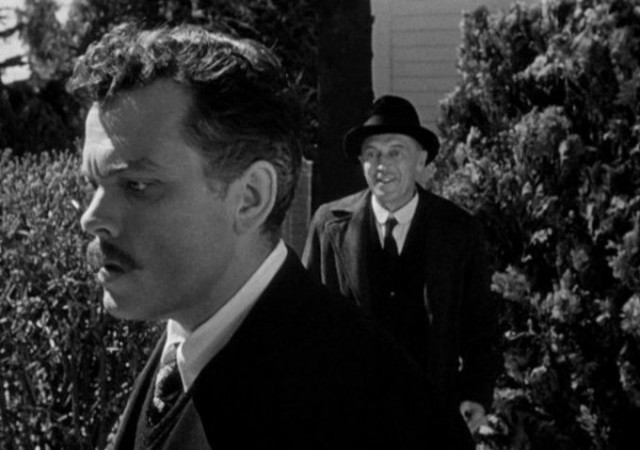THE STRANGER (Orson Welles, 1946)
MoMA Film, Museum of Modern Art
11 West 53rd St. between Fifth & Sixth Aves.
Saturday, April 27, 2:00, and Sunday, April 28, 5:30
Tickets: $12, in person only, may be applied to museum admission within thirty days, same-day screenings free with museum admission, available at Film and Media Desk beginning at 9:30 am
212-708-9400
www.moma.org
 A mere warm-up to The Third Man, Orson Welles’s 1946 noir thriller, The Stranger, is still a gripping examination of postwar paranoia and Fascism. Welles, who directed the film to show studio heads that he could be a team player, stars as Dr. Charles Rankin, a seemingly bright and charming teacher who shows up in a small town and wins the heart of Mary Longstreet (Loretta Young), daughter of the town judge (Philip Merivale). However, right behind Rankin is Mr. Wilson (Edward G. Robinson, somewhat reprising his role as insurance investigator Barton Keyes in Double Indemnity), who is hot on the trail of Nazi murderer Franz Kindler. What follows is a highly theoretical battle of wits between Wilson and Rankin/Kindler that is more than a little out of place in the simple perfection of small-town Harper, Connecticut. “The German’s dream world comes alive when he takes his place in shining armor beneath the banners of the Teutonic knights,” Rankin says during a family dinner reminiscent of Alfred Hitchcock’s Shadow of a Doubt. “Mankind is waiting for the Messiah,” he continues, “but for the German, the Messiah is not the Prince of Peace. No, he’s . . . another Barbarossa . . . another Hitler.” In addition to philosophizing, Rankin is obsessed with trying to fix the clock in the town tower, with his efforts trying to control time leading to a memorable finale. Rankin is no Harry Lime — of course, who is? — but he’s yet another intriguing character in Welles’s pantheon of intriguing characters. There are several amateurish moments that bring the film down a notch from greatness, but The Stranger remains a compelling tale with more than its fair share of Wellesian delight. After years of late-night television airings of a dilapidated print, the film was restored about ten years ago and looks much better on the big screen, where it can be seen April 27 & 28 as part of MoMA’s “The Weimar Touch” series, which includes such other films as Jacques Tourneur’s Berlin Express, Max Ophuls’s Letter from an Unknown Woman, Alfred Hitchcock’s I Confess, Charles Laughton’s The Night of the Hunter, and Billy Wilder’s Some Like It Hot, all of which relate visually or thematically to the German cinema of F. W. Murnau, Carl Th. Dreyer, G. W. Pabst, and Weimar Expressionism.
A mere warm-up to The Third Man, Orson Welles’s 1946 noir thriller, The Stranger, is still a gripping examination of postwar paranoia and Fascism. Welles, who directed the film to show studio heads that he could be a team player, stars as Dr. Charles Rankin, a seemingly bright and charming teacher who shows up in a small town and wins the heart of Mary Longstreet (Loretta Young), daughter of the town judge (Philip Merivale). However, right behind Rankin is Mr. Wilson (Edward G. Robinson, somewhat reprising his role as insurance investigator Barton Keyes in Double Indemnity), who is hot on the trail of Nazi murderer Franz Kindler. What follows is a highly theoretical battle of wits between Wilson and Rankin/Kindler that is more than a little out of place in the simple perfection of small-town Harper, Connecticut. “The German’s dream world comes alive when he takes his place in shining armor beneath the banners of the Teutonic knights,” Rankin says during a family dinner reminiscent of Alfred Hitchcock’s Shadow of a Doubt. “Mankind is waiting for the Messiah,” he continues, “but for the German, the Messiah is not the Prince of Peace. No, he’s . . . another Barbarossa . . . another Hitler.” In addition to philosophizing, Rankin is obsessed with trying to fix the clock in the town tower, with his efforts trying to control time leading to a memorable finale. Rankin is no Harry Lime — of course, who is? — but he’s yet another intriguing character in Welles’s pantheon of intriguing characters. There are several amateurish moments that bring the film down a notch from greatness, but The Stranger remains a compelling tale with more than its fair share of Wellesian delight. After years of late-night television airings of a dilapidated print, the film was restored about ten years ago and looks much better on the big screen, where it can be seen April 27 & 28 as part of MoMA’s “The Weimar Touch” series, which includes such other films as Jacques Tourneur’s Berlin Express, Max Ophuls’s Letter from an Unknown Woman, Alfred Hitchcock’s I Confess, Charles Laughton’s The Night of the Hunter, and Billy Wilder’s Some Like It Hot, all of which relate visually or thematically to the German cinema of F. W. Murnau, Carl Th. Dreyer, G. W. Pabst, and Weimar Expressionism.
